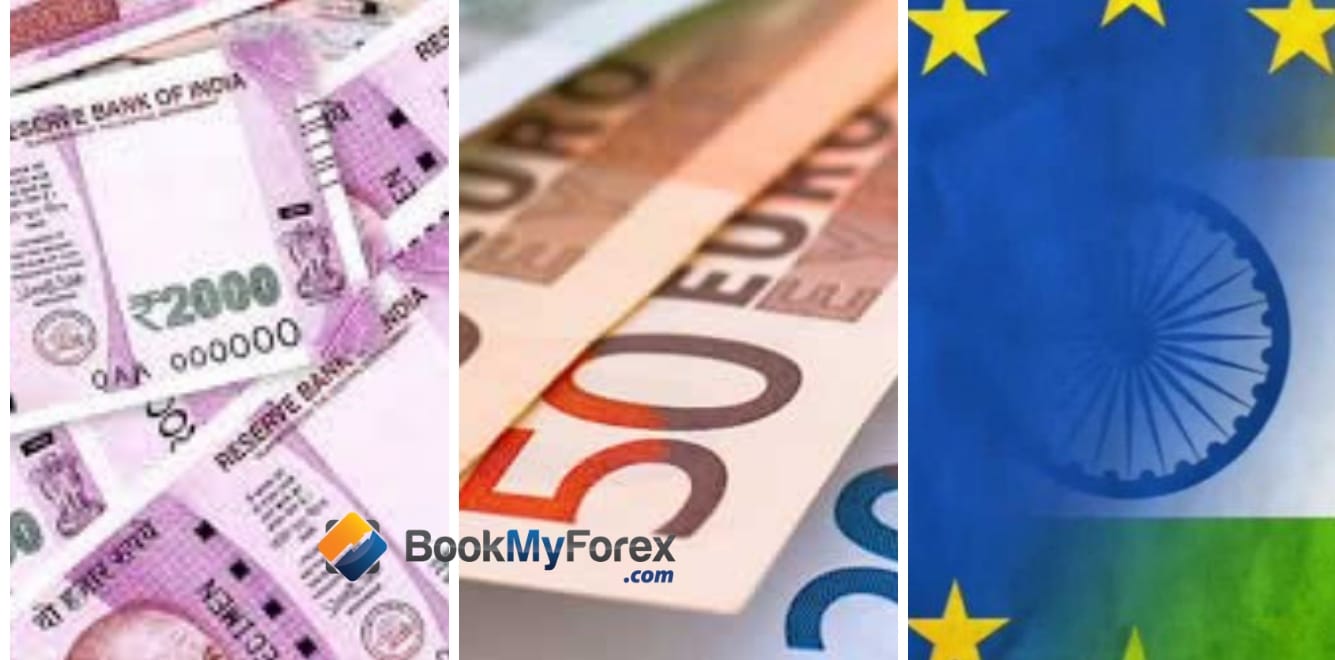Introduction:
Euro is the official currency of the 19 members of the European Union. It is the second most traded currency in the world after US Dollar. Euro was established in the 1992 Maastricht Treaty with the name Euro officially adopted in December of 1995.
INR is the official currency of India. Euro to INR is a very popular exchange rate as many Indians travel to Europe for holidays especially during the summer months to escape the heat. European countries are also very famous honeymoon destinations and people from across the globe visit there including Indians.
Value of 1 EUR to INR from 1990 till today
Given below is a table listing the value of 1 EUR in relation to INR from 1990 till date.
| Year | EUR to INR | Year | EUR to INR |
|---|---|---|---|
| 1990 | 24.93 | 2008 | 63.61 |
| 1991 | 34.48 | 2009 | 67.36 |
| 1992 | 43.73 | 2010 | 60.59 |
| 1993 | 38.71 | 2011 | 64.89 |
| 1994 | 39.78 | 2012 | 68.6 |
| 1995 | 44.93 | 2013 | 77.93 |
| 1996 | 45.38 | 2014 | 81.04 |
| 1997 | 43.57 | 2015 | 71.02 |
| 1998 | 50.37 | 2016 | 74.37 |
| 1999 | 50.73 | 2017 | 73.53 |
| 2000 | 45.32 | 2018 | 80.07 |
| 2001 | 42.25 | 2019 | 78.84 |
| 2002 | 45.92 | 2020 | 84.64 |
| 2003 | 52.61 | 2021 | 87.44 |
| 2004 | 56.3 | 2022 | 82.72 |
| 2005 | 54.81 | 2023 | 89.20 |
| 2006 | 56.84 | ||
| 2007 | 56.42 |
Historical Events That Noticeably Impacted EUR to INR Rate
The following have had a direct impact on the Euro and the Indian rupee, shaping their exchange rate dynamics.
-
Asian financial crisis (1997-1998)
The Asian financial crisis was a crisis that commenced in Thailand in July 1997 and unfolded in other Asian nations, including India. It happened due to various factors, which include high asset costs, immoderate lending, and currency speculations.
The Asian financial crisis had a notable impact on the Indian economic system, and the EUR to INR rate was no exception. The crisis prompted a sharp decline for the Indian rupee, which depreciated towards the euro and the rate jumped from 43.57 to 50.37 during that time
-
2000 dot-com bubble (2000-2001)
The dot-com bubble was a speculative bubble in the stock market that was driven by the rapid growth of the Internet and Internet-associated companies.
The bubble burst in March 2000, when stock prices of many internet-related businesses dropped extensively. This led to a decline in investor confidence and slower financial growth in the eurozone. As a result, the euro depreciated against many other currencies, including the Indian rupee.
In addition, the dot-com bubble burst coincided with a period of strong economic growth in India. India’s GDP rate averaged 7.1% between 1999 and 2000, which was higher than the growth rate of many other nations at that time. This robust growth additionally helped to support the value of the rupee.
-
Financial crisis (2007-2008)
The 2007-2008 financial crisis was a global financial crisis that was the worst economic downturn since the Great Depression. The crisis was caused by a number of factors, including excessive lending, subprime mortgages, and the collapse of the housing market in the United States.
This 2007-2008 financial crisis had a global impact. The Indian rupee took a hit, and the value dropped big time. As a result, the EUR to INR exchange rate surged from 56.42 to 63.61 during that chaotic time.
-
European sovereign debt crisis (2010)
The European sovereign debt crisis was a financial crisis that began in Greece in 2010 and spread to other European countries, including Portugal, Ireland, Spain, and Italy. The crisis was caused by a number of factors, including high government debt levels, low economic growth, and a lack of confidence in the European financial system.
The impact? Well, the EUR lost value against the INR. It led to the decline of EUR against INR and the rate went down from 67.36 to 60.59 in the same year.
-
Indian rupee crisis (2013)
India experienced a currency crisis in 2013, commonly referred to as the “Indian Rupee Crisis.”. The crisis was a result of a number of factors, together with a big cutting-edge account deficit, excessive inflation, and political uncertainty.
India had a massive current account deficit in 2013, which meant that it was importing more goods and services than it was exporting. This led to a demand for foreign currency, which placed a downward strain on the rupee.
Due to the 2013 Indian rupee crisis, the rupee depreciated sharply against the US dollar and other major currencies including the Euro. Between the year 2012-2013, the EUR to INR exchange rate increased sharply from 68.6 to 77.93.
-
Brexit (2016)
Brexit, short for “British Exit,” refers to the historic event that took place on June 23, 2016, when the United Kingdom (UK) voted to leave the European Union (EU). This decision had implications not only for the UK but also for the global economy.
This decision sparked uncertainty and volatility in financial markets, leading to fluctuating exchange rates. Following the referendum, the EUR to INR rate experienced considerable movement. The Euro witnessed a relatively small decline, causing the EUR to INR rate to drop from 74.37 to 73.53 in the aftermath of the referendum.
-
Rise in Oil Prices (2018)
In 2018, the world witnessed a sharp rise in oil prices. One of the primary reasons was the elevated demand for oil from China, the world’s largest consumer of crude oil. As China’s economic system continued to grow, its demand for energy accelerated as well. This uptick in demand had repercussions for countries like India, which heavily rely on oil imports.
In addition to increased demand, disruptions in oil supply from Iran exacerbated the scenario. In the case of Iran, the United States’ decision to reimpose economic sanctions on the country created uncertainty within the global oil market. These sanctions confined Iran’s ability to export oil, thereby reducing the overall supply available in the market.
As India heavily relies on oil imports, it bore the brunt of these price surges. The consequences caused the depreciation of the Indian rupee against major currencies, including the EURO. This depreciation resulted in the EUR to INR exchange rate surging from 73.53 to 80.07.
-
COVID-19 pandemic (2020)
The COVID-19 pandemic has had a profound effect on the global economy, and the EUR to INR exchange rate has not been immune to its impact. In this period, the Indian Rupee (INR) experienced depreciation against the Euro (EUR).
One of the main factors was the flight of capital from emerging markets to safer havens, such as the Eurozone, during times of uncertainty. Investors sought stability in developed economies, which led to an increased demand for the Euro and subsequently a depreciation of the INR.
-
Russia-Ukraine war (2022)
The Russia-Ukraine conflict had a substantial impact on the EUR to INR exchange rate. This conflict led to a surge in energy and food prices, spurring inflation. It also impacted investor confidence and brought about a slowdown in economic growth. Consequently, the Euro depreciated against many other currencies, including the Indian Rupee during this period.
Currency Dynamics between EUR and INR
Various elements impact the dynamics between these two currencies such as:
- Trade relations: Bilateral trade, including imports and exports of goods and services, can affect the demand for each currency. A higher demand for EUR from Indian consumers can lead to an appreciation of the EUR against the INR, while a higher demand for INR from Eurozone countries can result in a depreciation of the EUR against the INR.
- Economic Performance: Strong economic growth in the Eurozone typically boosts the demand for the Euro, causing it to appreciate against the INR. Conversely, when India’s economy performs well, the increased demand for INR strengthens its value against the Euro.
- Interest Rates: Higher interest rates in the Eurozone can attract foreign investors seeking better returns, leading to an increased demand for the Euro and consequently strengthening its value against the INR. Conversely, lower interest rates in the Eurozone can result in reduced interest from investors, causing the Euro to weaken against the INR.
- Political Stability and Geopolitical Factors: Any major political events or uncertainties in either the Eurozone or India can cause fluctuations in the exchange rate. Instances of political instability or shifts in government policies can create volatility in the currency markets, impacting the relationship between EUR and INR.






























Leave a Reply